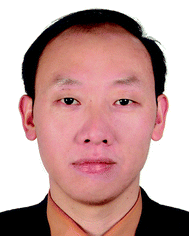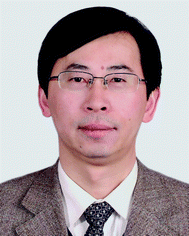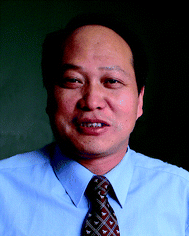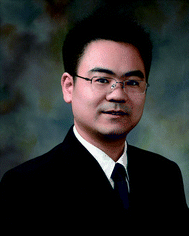Themed issue on flexible energy storage and conversion
Guozhen
Shen
a,
Shu-Hong
Yu
b,
Yongyao
Xia
c and
Xiong Wen (David)
Lou
d
aState Key Laboratory for Superlattices and Microstructures, Institute of Semiconductors, Chinese Academy of Sciences, Beijing 100083, P.R. China. E-mail: gzshen@semi.ac.cn
bDivision of Nanomaterials and Chemistry, Hefei National Laboratory for Physical Sciences at Microscale, Collaborative Innovation Center of Suzhou Nano Science and Technology, Department of Chemistry, University of Science and Technology of China, Hefei, P.R. China. E-mail: shyu@ustc.edu.cn
cDepartment of Chemistry and Shanghai Key Laboratory of Molecular Catalysis and Innovative Materials, Institute of New Energy, Fudan University, Shanghai 200433, P.R. China. E-mail: yyxia@fudan.edu.cn
dSchool of Chemical and Biomedical Engineering, Nanyang Technological University, 62 Nanyang Drive, Singapore. E-mail: xwlou@ntu.edu.sg
 Guozhen Shen |
 Shu-Hong Yu |
 Yongyao Xia |
 Xiong Wen (David) Lou |
Flexible devices have attracted extensive attention for many promising applications. Flexible electronics are exactly what they sound like: electronic devices that can be bent and stretched into any shape, time and time again. To realize fully flexible devices, one should consider making flexible energy conversion and storage units with high energy storage and power density. As future electronic systems become thinner, lighter and cheaper, the size of these systems mainly depends on their energy units. Most of the current existing energy storage and conversion devices are still too bulky and heavy. During the past several years, exciting work has been done to develop high performance flexible energy conversion and storage devices, such as flexible batteries, supercapacitors, solar cells and fuel cells.
Because of the rapid development of flexible energy conversion and storage in recent years, we would like to take the opportunity to launch this themed issue focusing on flexible energy storage and conversion. The aim of this themed issue is to highlight remarkable contributions made by the leading scientists in this important research area and to cover the broad impacts of flexible energy storage and conversion. This themed issue contains 6 feature articles, 2 communications and 20 research articles.
As one of the flexible power sources, flexible lithium batteries have gained great interest. Flexible lithium batteries with high safety, long cycle life and high rate performance are very important for their applications. In the feature article by Sun et al. (DOI: 10.1039/c4ta00716f), comprehensive reviews are given on flexible rechargeable lithium ion batteries, with a focus on materials and process technologies. In the paper by Wu et al. (DOI: 10.1039/c4ta00565a), summaries on green energy storage chemistries based on neutral aqueous electrolytes are highlighted. Besides, another 6 research papers by experts discuss the flexible electrodes (metal oxides, nitride, composites, graphene, etc.), electrolytes, lithium reaction mechanism, as well as battery structures, which are key factors for high performance lithium ion batteries (DOI: 10.1039/c3ta15123a, 10.1039/c4ta00364k, 10.1039/c4ta00371c, 10.1039/c4ta00494a, 10.1039/c4ta00551a and 10.1039/c4ta00987h). Besides lithium ion batteries, lithium–sulfur batteries were also introduced by Zhang et al. (DOI: 10.1039/c4ta00245h) in this themed issue.
Supercapacitors are another group of energy storage devices, which have the features of high power density, long cycling life and high energy efficiency. Dai et al. (DOI: 10.1039/c4ta00567h) highlighted the most recent progress in flexible supercapacitors based on carbon nanomaterials. Different kinds of flexible supercapacitors with carbon, graphene, graphene oxide, metal oxides, composites, polymers, etc. as the electrodes are designed and reported by experts in this themed issue, which will give the readers clear information on how to design high performance flexible supercapacitors (DOI: 10.1039/c3ta15293f, 10.1039/c3ta15391f, 10.1039/c4ta00492b, 10.1039/c4ta00538d, 10.1039/c4ta00875h, 10.1039/c4ta00969j, 10.1039/c4ta00988f, 10.1039/c4ta01547a and 10.1039/c4ta01245c). Also, in the feature article by Gogotsi (DOI: 10.1039/c4ta00203b), new types of textile energy storage devices are overviewed and perspectives on the field of textile energy storage with a specific emphasis on devices made from textiles or made as a fabric themselves are discussed.
Solar cells are the main energy conversion devices, which can efficiently convert sunlight into electricity. This themed issue will provide the readers with two papers on organic solar cells (DOI: 10.1039/c4ta00301b) and dye-sensitized solar cells (DOI: 10.1039/c4ta00563e) along with reviews of the latter (DOI: 10.1039/c4ta00902a) and semiconductor:insulator polymer blends for optoelectronic applications (DOI: 10.1039/c4ta01065e). Besides solar cells, nanogenerators based on p–n junction-based ZnO nanowires (DOI: 10.1039/c4ta01714e), thermoelectric devices on Ga-containing thermoelectric skutterudites (DOI: 10.1039/c4ta00487f), ZIF-templated carbons for hydrogen and CO2 storage applications (DOI: 10.1039/c4ta00530a) and flexible transparent conductive films (DOI: 10.1039/c4ta00527a) are also discussed in this themed issue.
Although it is not possible to include all of the important topics in this fast developing and attractive field, we hope this themed issue with a small collection of papers can provide the readers with an overview of the recent progress achieved and the future developing directions in the flexible energy storage and conversion field.
We would like to thank all the authors who have contributed high-quality peer-reviewed articles that advance state-of-the-art research to this themed issue. We sincerely hope that this themed issue could provide a valuable reference and perspective for the research community working in this exciting field and inspire many more to enter it. We are also grateful to the editorial and production staff of Journal of Materials Chemistry A for their superb assistance.
Acknowledgements
We thank the Department of Information Sciences, National Natural Science Foundation of China (NSFC) for the support received for this themed issue.| This journal is © The Royal Society of Chemistry 2014 |
